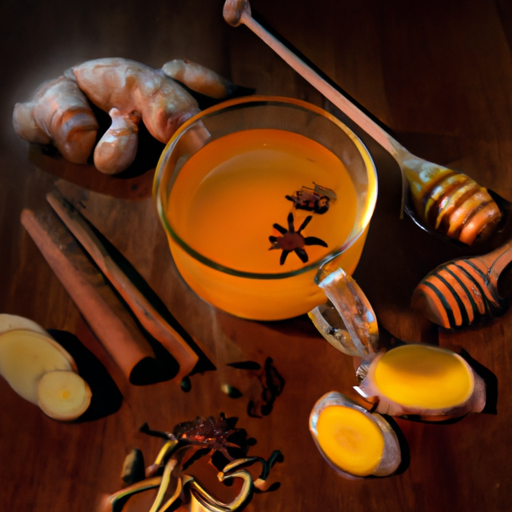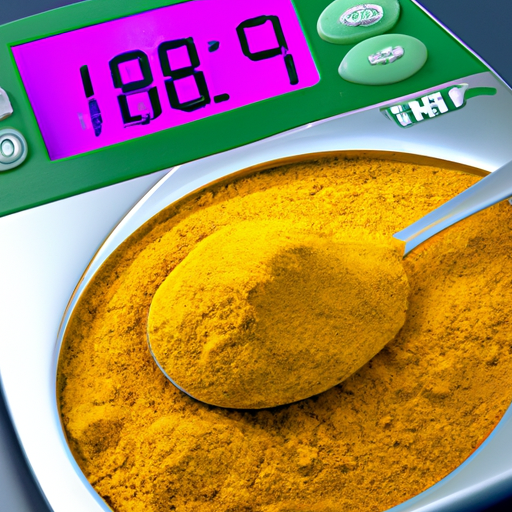Being always interested in natural methods to enhance my health, I have recently come across the incredible advantages of turmeric. This bright orange spice has a long history in traditional medicine and is now widely recognized in the Western world for its potent anti-inflammatory properties.
One of my favorite ways to incorporate turmeric into my daily routine is by making a warm and comforting cup of turmeric tea. In this article, I’ll be sharing with you everything I’ve learned about turmeric and how you can make your own delicious and healing cup of turmeric tea at home.
From the key nutrients and compounds found in turmeric to its potential side effects and recommended dosages, I’ll cover all aspects of this incredible spice. So whether you’re looking for a natural way to reduce inflammation, boost your immune system or simply add more flavor to your meals, read on to discover the many benefits of turmeric!
Key Takeaways
- Turmeric is a natural way to improve health, with powerful anti-inflammatory and cancer-fighting potential, and is a great source of manganese and iron.
- Turmeric tea is a favorite way to incorporate turmeric into daily routine, and can be customized with variations and additions like milk, honey, ginger, or lemon for flavor and additional health benefits.
- Curcumin is the most well-known compound in turmeric and enhances bioavailability when consumed with black pepper or piperine.
- Turmeric can be added to meals like smoothies, soups, and curries, and is also available in supplement form, though it should be taken under the guidance of a healthcare professional. More high-quality studies are needed to draw definitive conclusions about its effectiveness for various health conditions.
Understanding the Key Nutrients and Compounds in Turmeric
I love using turmeric in my cooking because it not only adds a delicious flavor, but it’s also packed with key nutrients and compounds that provide numerous health benefits.
One of the most well-known compounds in turmeric is curcumin, which has powerful anti-inflammatory properties and may even have cancer-fighting potential.
Additionally, turmeric is a great source of manganese and iron, both of which are essential minerals for maintaining healthy bones, metabolism, and blood sugar levels.
Curcumin
To fully reap the benefits of curcumin, you’ll want to make sure that you’re consuming it in combination with black pepper or a source of piperine. This is because piperine enhances the bioavailability of curcumin in the body by up to 2000%.
Here are some other important things to know about curcumin:
- Curcumin has been extensively researched for its anti-inflammatory and antioxidant properties.
- Some studies have suggested that curcumin may be helpful in managing chronic conditions like arthritis, diabetes, and heart disease.
- While turmeric contains only around 3% curcumin by weight, there are many turmeric supplements available that contain higher concentrations of this beneficial compound.
- However, it’s important to note that supplementation should always be done under the guidance of a healthcare professional.
- Additionally, while research on curcumin shows promise, more high-quality studies are needed before definitive conclusions can be drawn about its effectiveness for various health conditions.
Moving onto the next topic, manganese is another key nutrient found in turmeric that plays an important role in overall health.
Manganese
Manganese, a vital mineral found in turmeric, is crucial for various bodily functions and can positively impact overall health. One of its benefits is that it helps to support bone health.
Manganese plays a key role in the formation of connective tissues, which are essential for strong bones. Additionally, studies have shown that manganese can help to increase bone density, reducing the risk of fractures and osteoporosis.
Turmeric is an excellent source of manganese, with one teaspoon containing approximately 10% of your daily recommended intake. Other sources include nuts, whole grains, and leafy green vegetables. Incorporating these foods into your diet can provide you with the necessary amount of manganese to support good health and strong bones.
As we move on to discussing iron in the next section, it’s important to note that both minerals work together synergistically in the body to support healthy blood production.
Iron
Iron is like a superhero for our bodies, swooping in to save the day by carrying oxygen throughout our bloodstream. This essential mineral plays a crucial role in the production of hemoglobin, which is responsible for transporting oxygen from the lungs to all parts of the body. Without enough iron, our cells would be deprived of this vital element, leading to fatigue and weakness.
Incorporating iron-rich foods into your diet can offer numerous health benefits. Here are three reasons why you should consider adding more iron to your meals:
- Iron helps support healthy brain function and cognitive development.
- Adequate iron intake can boost energy levels and reduce feelings of tiredness.
- Iron is essential for maintaining a strong immune system.
Now that we know about the importance of iron, let’s talk about another powerful natural ingredient – turmeric. This spice has gained popularity in recent years due to its potent anti-inflammatory properties.
The Powerful Anti-Inflammatory Properties of Turmeric
You may not know this, but turmeric is a powerful anti-inflammatory spice that can help alleviate joint pain and reduce inflammation throughout your body. It’s no wonder why turmeric supplements are becoming increasingly popular as people seek natural ways to manage chronic pain.
But did you know that you can also incorporate turmeric into your daily diet through its culinary uses? Not only does adding turmeric to your meals give them a beautiful golden hue, but it also adds flavor and health benefits. You can use it in curries, stir-fries, soups, and even smoothies. The possibilities are endless!
So next time you’re cooking up a storm in the kitchen, don’t forget to sprinkle some turmeric on top for an extra boost of anti-inflammatory power. And if you really want to maximize its benefits, try making some delicious turmeric tea – which I’ll show you how to do next!
How to Make Turmeric Tea
I love drinking turmeric tea because of its healing properties and delicious taste. Making a basic turmeric tea is easy – all you need is water, turmeric powder, and honey or lemon for flavor.
However, there are many variations and additions you can try to customize your tea and maximize its health benefits.
Basic Turmeric Tea Recipe
First, grab your favorite mug and fill it with water. Place the mug in the microwave for 1-2 minutes or until the water is hot but not boiling.
Next, add 1/2 teaspoon of ground turmeric to the hot water and stir until well mixed. Then, add a pinch of black pepper to help increase the absorption of curcumin, which is the main active ingredient in turmeric.
After adding black pepper, you can also customize your basic turmeric tea recipe by adding any of these four variations: 1) a splash of milk or cream for a creamy texture similar to a turmeric latte; 2) a spoonful of honey or maple syrup for sweetness; 3) a slice of fresh ginger for added flavor and anti-inflammatory benefits; or 4) blend all ingredients together with ice cubes for a refreshing turmeric smoothie.
With such simple steps and options available, making this healthy beverage at home hasn’t ever been easier!
Variations and Additions
Get ready to enhance the flavor and boost the health benefits of your turmeric tea with these simple variations that will leave you feeling refreshed and satisfied.
One easy way to add more depth to your turmeric tea is by experimenting with different flavor combinations. For example, adding a slice of fresh ginger or a pinch of cinnamon can give your tea a warming kick, while a splash of lemon juice can liven it up with a citrusy zing.
Not only do these additions make your turmeric tea more delicious, but they also offer additional health benefits. Ginger has been shown to reduce inflammation and ease digestive issues, while cinnamon may help regulate blood sugar levels and improve cognitive function. Meanwhile, lemon contains vitamin C and antioxidants that support immune function and skin health.
So go ahead and get creative with your turmeric tea – the possibilities are endless!
Ready to take your turmeric tea game to the next level? Check out our tips for brewing the perfect cup of this healing elixir in the next section.
Tips for Brewing the Perfect Cup of Turmeric Tea
To brew the perfect cup of turmeric tea, start by bringing water to a boil. Then add your desired amount of turmeric powder or fresh grated turmeric. For a single serving, I typically use 1 teaspoon of turmeric powder or 1 tablespoon of freshly grated turmeric for a stronger flavor.
Let the turmeric simmer for about 10 minutes before straining out any leftover bits. Brewing techniques can vary depending on personal preference. Some people like to add other spices such as cinnamon or ginger to their tea for added flavor combinations. Others prefer to sweeten their tea with honey or agave nectar.
No matter how you choose to prepare your turmeric tea, remember that consistency is key in reaping its many health benefits. Now let’s move on to other creative ways to incorporate turmeric into your diet.
Other Creative Ways to Incorporate Turmeric into Your Diet
Let’s explore some fun and flavorful ways to add the golden goodness of turmeric into your daily diet. First up, let’s talk about turmeric smoothies! Adding a teaspoon of turmeric powder to your favorite fruit smoothie recipe can give it an extra boost of anti-inflammatory properties. Not only does it add a vibrant color, but it also adds a subtle earthy flavor that pairs well with sweet fruits like mango and pineapple.
Another way to incorporate turmeric is by making your own spice blend. Mix together equal parts ground turmeric, cumin, coriander, and smoked paprika for a savory spice blend that can be used on roasted vegetables or grilled meats. This blend not only adds depth of flavor but also has immune-boosting benefits from the combination of spices.
So, get creative in the kitchen and find new ways to enjoy this powerful spice! Now, let’s move on to the next section about precautions and potential side effects…
Precautions and Potential Side Effects
Before you start incorporating turmeric into your diet, it’s important to be aware of the potential side effects and precautions in order to protect your health. Turmeric is generally safe for most people when consumed in small amounts as a spice or food ingredient. However, taking high doses of turmeric supplements may cause gastrointestinal issues such as nausea, diarrhea, and stomach upset.
Here are some precautions and potential side effects to keep in mind when using turmeric:
- Turmeric can increase bleeding risk if taken with blood-thinning medications.
- High doses of turmeric may lower blood sugar levels, which can be dangerous for people with diabetes.
- Turmeric may interfere with iron absorption and worsen anemia symptoms.
- Pregnant women should avoid large amounts of turmeric as it may stimulate the uterus.
Recommended dosages and frequency of use will be discussed in the next section.
Recommended Dosages and Frequency of Use
When it comes to incorporating turmeric into your diet, it’s important to know the recommended dosages and frequency of use. While turmeric is generally safe when consumed in small amounts as a spice, taking high doses as a supplement may lead to potential risks such as gastrointestinal issues and interactions with certain medications. It’s always best to consult with a healthcare professional before beginning any new supplement regimen.
To help you understand how much turmeric is safe for consumption, here’s a table outlining the recommended dosages and frequency of use:
| Form | Dosage | Frequency |
|---|---|---|
| Powder or Fresh Root | 1-3 grams daily | Up to 3 times per day |
| Standardized Curcumin Extract Supplements (95% curcuminoids) | 500 milligrams twice daily (totaling 1000 milligrams) | Daily |
It’s also important to note that combining turmeric with other herbs may impact its effects. For example, combining turmeric with black pepper can increase absorption of its active compound, curcumin. Overall, practicing safe usage when incorporating this powerful spice into your diet can provide numerous health benefits without causing harm.
Moving forward, let’s take a closer look at some additional health benefits of turmeric.
Additional Health Benefits of Turmeric
You may be surprised to learn that turmeric has anti-inflammatory and antioxidant properties that can potentially help with conditions such as arthritis, heart disease, and even cancer.
In addition to these benefits, there are other reasons why you might want to consider incorporating turmeric into your daily routine. Here are a few examples:
- Turmeric supplements have been found to improve brain function and reduce the risk of brain diseases.
- Some studies suggest that turmeric can help with depression by increasing levels of serotonin and dopamine in the brain.
- Turmeric can also be used topically for skincare purposes due to its anti-inflammatory properties.
Overall, adding turmeric to your diet or skincare routine may offer some surprising health benefits. However, it’s important to talk with your healthcare provider before starting any new supplement regimen or using turmeric for medicinal purposes.
Frequently Asked Questions
What is the origin of turmeric and how has it been used historically?
As someone who loves to learn about the history of herbs and spices, I can tell you that turmeric’s origin can be traced back to Southeast Asia. Its historical use spans centuries, from culinary dishes to natural dye and beauty routines. However, we must also consider the impacts of harvesting on its cultural significance. Remember: "Old is gold."
Are there any cultural or religious associations with the use of turmeric?
Turmeric has cultural significance in Hinduism and is used in weddings and religious ceremonies. Its medicinal properties have been recognized for centuries, with studies showing its effectiveness in treating inflammation, pain, and digestive issues.
Can turmeric be used as a natural dye and what are the best fabrics to use for this purpose?
Turmeric’s vibrant hues make it perfect for natural dyeing. Cotton, silk, and wool are best for absorbing the deep yellows and oranges. Its role in fashion and textiles dates back centuries, adding a touch of warmth to any garment.
How can turmeric be incorporated into beauty and skincare routines?
Turmeric is a great addition to your beauty routine! I use it in my turmeric face mask and turmeric body scrub. It’s anti-inflammatory properties can help reduce redness and brighten skin. Mix with honey for added benefits.
Are there any environmental or social impacts associated with the harvesting and production of turmeric?
As I delved into the world of turmeric, I discovered its environmental impacts and social implications. Its cultivation requires a lot of water and can lead to soil erosion. Furthermore, inadequate labor policies in some regions may result in exploitation.
Conclusion
In conclusion, turmeric has truly been a game-changer in my life. It’s like the superhero that swoops in and saves the day when my body is feeling out of whack.
Just like how Batman uses his gadgets to take down villains, I use turmeric to combat inflammation and boost my overall health.
But just like any superhero, there are precautions that need to be taken. It’s important to follow recommended dosages and frequency of use, as well as being aware of potential side effects.
And while incorporating turmeric into your diet can bring about numerous health benefits, it’s always best to consult with a healthcare professional before making any major changes to your lifestyle.
So go ahead and give turmeric tea or other creative ways to incorporate this healing spice a try! Who knows, it may just become the Robin to your Batman in your journey towards optimal health.










